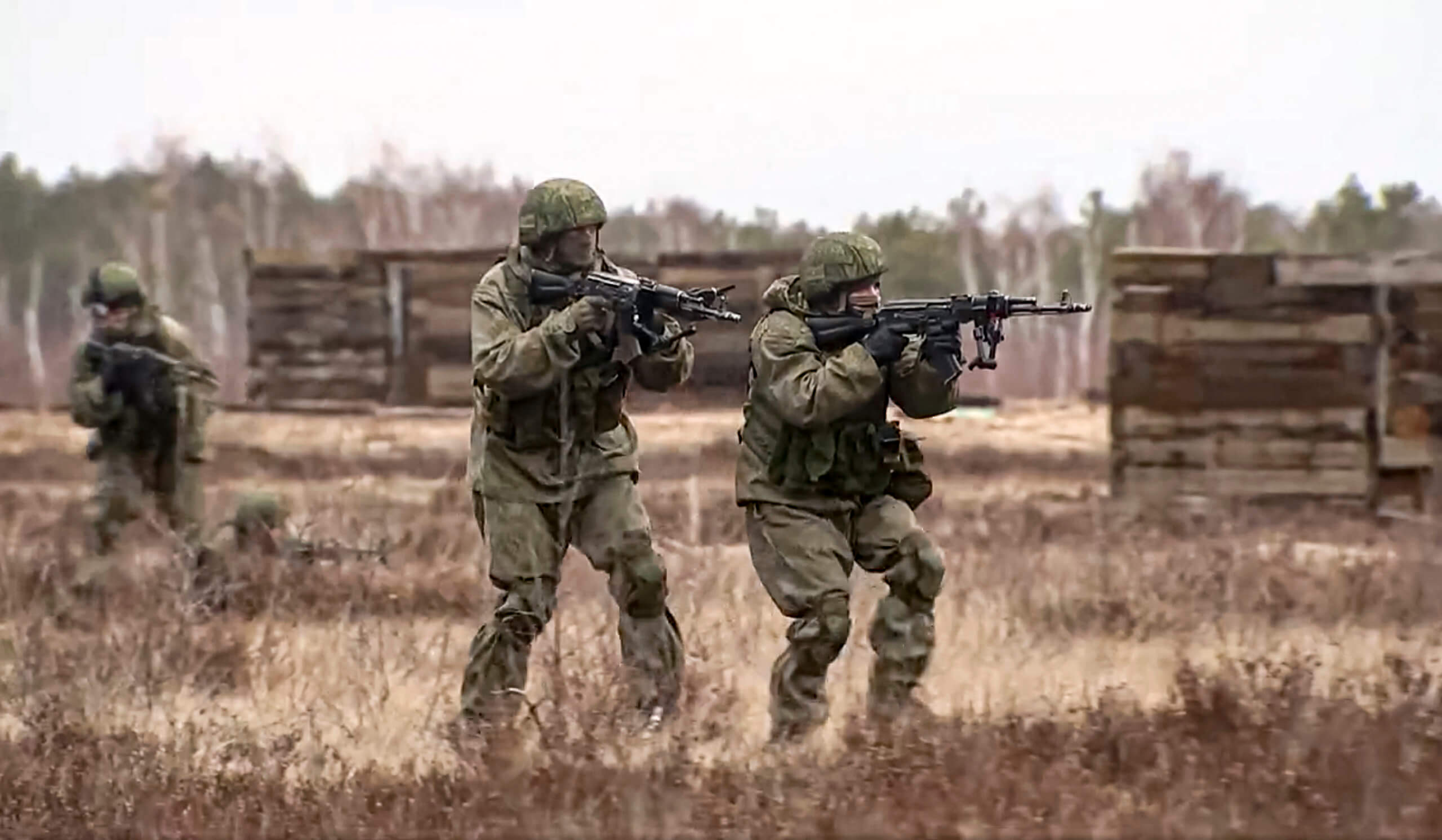
In this photo taken from video provided by the Russian Defense Ministry Press Service on Monday, Feb. 14, 2022, soldiers practice at the Obuz-Lesnovsky training ground during the Union Courage-2022 Russia-Belarus military drills in Belarus. (Russian Defense Ministry Press Service via AP)
Valentina Constantinovska is a great-grandmother in Ukraine. A tweet showing her training with an AK-47 to defend against a possible Russian attack is making headlines. She explained: “Your mother would do it too.”
According to Ukrainian President Volodymyr Zalenskyy, she may not have to wait long to defend her country.
In a speech to his nation yesterday, Mr. Zalenskyy stated: “We are told that February 16 will be the day of attack.” He added, “We will make it a union day. The decree has already been signed. This [Wednesday] afternoon, we will hang national flags, put on blue-yellow ribbons, and show the world our unity.”
President Biden reportedly agrees that an invasion could come tomorrow and believes that a physical assault could be preceded by a barrage of missile strikes and cyberattacks. One US official reportedly indicated that such cyberattacks are “imminent.” According to Ukrainian officials, cyberattacks, economic disruption, and hundreds of fake bomb threats have already begun.
In response to the rising threat, the US is closing its Kyiv embassy and relocating diplomatic operations 340 miles west near the Polish border. The Pentagon has withdrawn National Guard troops from Ukraine as well. And insurance companies have withdrawn coverage from airlines flying through Ukrainian airspace over an “imminent” invasion threat.
Why would Russia invade Ukraine?
“Threat” has been defined as hostile intent plus capability. For example, France’s nuclear arsenal is not a threat to the US (they possess capability but no intent). By contrast, keeping Iran from getting nuclear weapons is all about preventing intent from acquiring capability.
There is no question that Russia has the capability to invade Ukraine. Russia has already positioned its forces to attack the country from multiple directions. An “unprecedented Russian naval presence” in the Black and Mediterranean seas has created yet another threat to Ukraine. One Ukrainian official said such a concentration had not been seen since the Cold War ended three decades ago.
Why would Russia possess the intent to do so?
First, Russian President Vladimir Putin reportedly views Ukraine as fundamentally part of Russia.
In June, he published a five-thousand-word essay in which he claimed that “Russians and Ukrainians were one people.” He is still angry over Ukraine’s 2014 revolution, in which a pro-Western government replaced a regime aligned with Moscow. One analyst explained, “He still believes Ukraine is a kind of conspiracy, a kind of aberration.”
Second, Mr. Putin is reportedly concerned about security threats against his nation.
In his article, the Russian president stated that the formation of an ethnically Ukrainian state hostile to Moscow was “comparable in its consequences to the use of weapons of mass destruction against us.” One policy expert said that if Mr. Putin begins a military operation against Ukraine, “It will be to stake out territory where he believes there could be NATO missiles.” One analyst states, “I think he sees it as his duty as president not to leave this problem for the next leadership.”
As many as twenty-four million Russians died in World War II, a conflict that came to the USSR from Europe. Russia has lost fourteen countries that were once part of the USSR, many of which served as a buffer on its western border with Europe but have since joined NATO. Mr. Putin wants to halt NATO’s expansion, push its forces and equipment out of Eastern Europe and the Baltic states, and remove US nuclear weapons from Europe.
Third, Mr. Putin may be using this crisis to shore up political support in Russia.
The New York Times reports that he may be seeking to “energize nationalists at home support by focusing on an external threat, as he has in the past.” The Times notes that Mr. Putin has previously “crushed domestic challenges to his authority.” Last year, however, with the economy struggling and the pandemic raging, opposition groups held some of the largest anti-Putin protests in years.
According to the Atlantic, Mr. Putin deeply fears a democratic revolution that would threaten his power. As a result, “He wants to destabilize Ukraine, frighten Ukraine. He wants Ukrainian democracy to fail.” And “he wants to put so much strain on Western and democratic institutions, especially the European Union and NATO, that they break up.”
How should you and I respond?
Tomorrow, we’ll discuss what a Russian invasion of Ukraine could mean for the US and the West. For today, let’s close by focusing on what it would mean for Ukraine. As one military analyst notes, “Depending on what Russia’s military objectives are, the images that will go viral on social media could be too horrific to imagine.”
For example, a Russian attack on Ukraine’s military assets “will be shock and awe of a sophistication never before seen in the history of warfare.” If Russia mounts a full invasion, American officials estimate that fifty thousand civilians could die along with twenty-five thousand Ukrainian soldiers and ten thousand Russian military personnel. One to five million refugees would flee the country.
In the face of such potential devastation and suffering, you and I are called to “mourn with those who mourn” (Romans 12:15 NIV). I believe the Person who will mourn most if war comes in Ukraine is the God who loves every Ukrainian and every Russian (1 John 4:8). When we share his compassion for hurting people, we show our skeptical culture the relevance and grace of our Father and of our faith.
If your children or grandchildren were on the front lines of this potential war, how would you be praying?
William Wilberforce explained the passion and compassion that led him to help abolish the slave trade: “If to be feelingly alive to the sufferings of my fellow creatures is to be a fanatic, I am one of the most incurable fanatics ever permitted to be at large.”
Will you be such a “fanatic” today?











